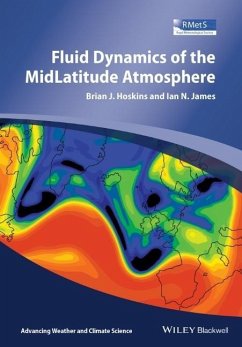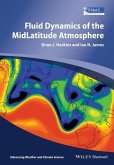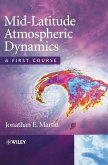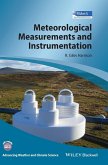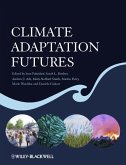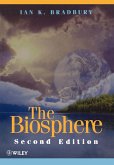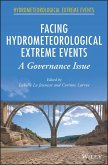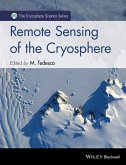- Gebundenes Buch
- Merkliste
- Auf die Merkliste
- Bewerten Bewerten
- Teilen
- Produkt teilen
- Produkterinnerung
- Produkterinnerung
This book gives a coherent development of the current understanding of the fluid dynamics of the middle latitude atmosphere. It is primarily aimed at post-graduate and advanced undergraduate level students and does not assume any previous knowledge of fluid mechanics, meteorology or atmospheric science. The book will be an invaluable resource for any quantitative atmospheric scientist who wishes to increase their understanding of the subject. The importance of the rotation of the Earth and the stable stratification of its atmosphere, with their implications for the balance of larger-scale…mehr
Andere Kunden interessierten sich auch für
![Fluid Dynamics of the Mid-Latitude Atmosphere Fluid Dynamics of the Mid-Latitude Atmosphere]() Brian HoskinsFluid Dynamics of the Mid-Latitude Atmosphere116,99 €
Brian HoskinsFluid Dynamics of the Mid-Latitude Atmosphere116,99 €![Mid-Latitude Atmospheric Dynam Mid-Latitude Atmospheric Dynam]() Jonathan E. MartinMid-Latitude Atmospheric Dynam272,99 €
Jonathan E. MartinMid-Latitude Atmospheric Dynam272,99 €![Meteorological Measurements and Instrumentation Meteorological Measurements and Instrumentation]() Giles HarrisonMeteorological Measurements and Instrumentation109,99 €
Giles HarrisonMeteorological Measurements and Instrumentation109,99 €![Climate Adaptation Futures Climate Adaptation Futures]() Climate Adaptation Futures189,99 €
Climate Adaptation Futures189,99 €![The Biosphere The Biosphere]() Ian K. BradburyThe Biosphere123,99 €
Ian K. BradburyThe Biosphere123,99 €![Facing Hydrometeorological Extreme Events Facing Hydrometeorological Extreme Events]() Facing Hydrometeorological Extreme Events170,99 €
Facing Hydrometeorological Extreme Events170,99 €![Remote Sensing of the Cryosphere Remote Sensing of the Cryosphere]() Marco TedescoRemote Sensing of the Cryosphere152,99 €
Marco TedescoRemote Sensing of the Cryosphere152,99 €-
-
-
This book gives a coherent development of the current understanding of the fluid dynamics of the middle latitude atmosphere. It is primarily aimed at post-graduate and advanced undergraduate level students and does not assume any previous knowledge of fluid mechanics, meteorology or atmospheric science. The book will be an invaluable resource for any quantitative atmospheric scientist who wishes to increase their understanding of the subject. The importance of the rotation of the Earth and the stable stratification of its atmosphere, with their implications for the balance of larger-scale flows, is highlighted throughout.
Clearly structured throughout, the first of three themes deals with the development of the basic equations for an atmosphere on a rotating, spherical planet and discusses scale analyses of these equations. The second theme explores the importance of rotation and introduces vorticity and potential vorticity, as well as turbulence. In the third theme, the concepts developed in the first two themes are used to give an understanding of balanced motion in real atmospheric phenomena. It starts with quasi-geostrophic theory and moves on to linear and nonlinear theories for mid-latitude weather systems and their fronts. The potential vorticity perspective on weather systems is highlighted with a discussion of the Rossby wave propagation and potential vorticity mixing covered in the final chapter.
Hinweis: Dieser Artikel kann nur an eine deutsche Lieferadresse ausgeliefert werden.
Clearly structured throughout, the first of three themes deals with the development of the basic equations for an atmosphere on a rotating, spherical planet and discusses scale analyses of these equations. The second theme explores the importance of rotation and introduces vorticity and potential vorticity, as well as turbulence. In the third theme, the concepts developed in the first two themes are used to give an understanding of balanced motion in real atmospheric phenomena. It starts with quasi-geostrophic theory and moves on to linear and nonlinear theories for mid-latitude weather systems and their fronts. The potential vorticity perspective on weather systems is highlighted with a discussion of the Rossby wave propagation and potential vorticity mixing covered in the final chapter.
Hinweis: Dieser Artikel kann nur an eine deutsche Lieferadresse ausgeliefert werden.
Produktdetails
- Produktdetails
- Advancing Weather and Climate Science
- Verlag: Wiley & Sons
- 1. Auflage
- Seitenzahl: 432
- Erscheinungstermin: 27. Oktober 2014
- Englisch
- Abmessung: 244mm x 170mm x 25mm
- Gewicht: 816g
- ISBN-13: 9780470833698
- ISBN-10: 0470833696
- Artikelnr.: 41390136
- Herstellerkennzeichnung
- Libri GmbH
- Europaallee 1
- 36244 Bad Hersfeld
- gpsr@libri.de
- Advancing Weather and Climate Science
- Verlag: Wiley & Sons
- 1. Auflage
- Seitenzahl: 432
- Erscheinungstermin: 27. Oktober 2014
- Englisch
- Abmessung: 244mm x 170mm x 25mm
- Gewicht: 816g
- ISBN-13: 9780470833698
- ISBN-10: 0470833696
- Artikelnr.: 41390136
- Herstellerkennzeichnung
- Libri GmbH
- Europaallee 1
- 36244 Bad Hersfeld
- gpsr@libri.de
Having gained mathematics degrees from Cambridge and spent some post-doc years in the USA, Brian Hoskins has been at the University of Reading for more than 40 years, being made a professor in 1981, and also more recently has led a climate institute at Imperial College London. His international activities have included being President of IAMAS and Vice-Chair of the JSC for WCRP. He is a member of the science academies of the UK, Europe, USA and China, he has received the top awards of both the Royal and American Meteorological Societies, the Vilhelm Bjerknes medal of the EGU and the Buys Ballot Medal, and he was knighted in 2007. From a background in physics and astronomy, Ian James worked in the geophysical fluid dynamics laboratory of the Meteorological Office before joining the University of Reading in 1979. During his 31 years in the Reading meteorology department, he has taught courses in dynamical meteorology and global atmospheric circulation. In 1998, he was awarded the Buchan Prize of the Royal Meteorological Society for his work on low frequency atmospheric variability. He has been President of the Dynamical Meteorology Commission of IAMAS, vice president of the Royal Meteorological Society, and currently edits the journal Atmospheric Science Letters. He now serves as an Anglican priest in Cumbria.
Series foreword ix
Preface xi
Select bibliography xv
The Authors xix
1 Observed flow in the Earth's midlatitudes 1
1.1 Vertical structure 1
1.2 Horizontal structure 4
1.3 Transient activity 11
1.4 Scales of motion 14
1.5 The Norwegian frontal model of cyclones 15
Theme 1 Fluid dynamics of the midlatitude atmosphere 25
2 Fluid dynamics in an inertial frame of reference 27
2.1 Definition of fluid 27
2.2 Flow variables and the continuum hypothesis 29
2.3 Kinematics: characterizing fluid flow 30
2.4 Governing physical principles 35
2.5 Lagrangian and Eulerian perspectives 36
2.6 Mass conservation equation 38
2.7 First Law of Thermodynamics 40
2.8 Newton's Second Law of Motion 41
2.9 Bernoulli's Theorem 45
2.10 Heating and water vapour 47
3 Rotating frames of reference 53
3.1 Vectors in a rotating frame of reference 53
3.2 Velocity and Acceleration 55
3.3 The momentum equation in a rotating frame 56
3.4 The centrifugal pseudo-force 57
3.5 The Coriolis pseudo-force 59
3.6 The Taylor-Proudman theorem 61
4 The spherical Earth 65
4.1 Spherical polar coordinates 65
4.2 Scalar equations 67
4.3 The momentum equations 68
4.4 Energy and angular momentum 70
4.5 The shallow atmosphere approximation 73
4.6 The beta effect and the spherical Earth 74
5 Scale analysis and its applications 77
5.1 Principles of scaling methods 77
5.2 The use of a reference atmosphere 79
5.3 The horizontal momentum equations 81
5.4 Natural coordinates, geostrophic and gradient wind balance 83
5.5 Vertical motion 87
5.6 The vertical momentum equation 89
5.7 The mass continuity equation 91
5.8 The thermodynamic energy equation 92
5.9 Scalings for Rossby numbers that are not small 95
6 Alternative vertical coordinates 97
6.1 A general vertical coordinate 97
6.2 Isobaric coordinates 100
6.3 Other pressure-based vertical coordinates 103
6.4 Isentropic coordinates 106
7 Variations of density and the basic equations 109
7.1 Boussinesq approximation 109
7.2 Anelastic approximation 111
7.3 Stratification and gravity waves 113
7.4 Balance, gravity waves and Richardson number 115
7.5 Summary of the basic equation sets 121
7.6 The energy of atmospheric motions 122
Theme 2 Rotation in the atmosphere 125
8 Rotation in the atmosphere 127
8.1 The concept of vorticity 127
8.2 The vorticity equation 129
8.3 The vorticity equation for approximate sets of equations 131
8.4 The solenoidal term 132
8.5 The expansion/contraction term 134
8.6 The stretching and tilting terms 135
8.7 Friction and vorticity 138
8.8 The vorticity equation in alternative vertical coordinates 144
8.9 Circulation 145
9 Vorticity and the barotropic vorticity equation 149
9.1 The barotropic vorticity equation 149
9.2 Poisson's equation and vortex interactions 151
9.3 Flow over a shallow hill 155
9.4 Ekman pumping 159
9.5 Rossby waves and the beta plane 160
9.6 Rossby group velocity 166
9.7 Rossby ray tracing 170
9.8 Inflexion point instability 172
10 Potential vorticity 177
10.1 Potential vorticity 177
10.2 Alternative derivations of Ertel's theorem 180
10.3 The principle of invertibility 182
10.4 Shallow water equation potential vorticity 186
11 Turbulence and atmospheric flow 189
11.1 The Reynolds number 189
11.2 Three-dimensional flow at large Reynolds number 194
11.3 Two-dimensional flow at large Reynolds number 196
11.4 Vertical mixing in a stratified fluid 201
11.5 Reynolds stresses 203
Theme 3 Balance in atmospheric flow 209
12 Quasi-geostrophic flows 211
12.1 Wind and temperature in balanced flows 211
12.2 The quasi-geostrophic approximation 215
12.3 Quasi-geostrophic potential vorticity 219
12.4 Ertel and quasi-geostrophic potential vorticities 221
13 The omega equation 225
13.1 Vorticity and thermal advection form 225
13.2 Sutcliffe Form 231
13.3 Q-vector form 233
13.4 Ageostrophic flow and the maintenance of balance 238
13.5 Balance and initialization 240
14 Linear theories of baroclinic instability 245
14.1 Qualitative discussion 245
14.2 Stability analysis of a zonal flow 247
14.3 Rossby wave interpretation of the stability conditions 256
14.4 The Eady model 264
14.5 The Charney and other quasi-geostrophic models 271
14.6 More realistic basic states 275
14.7 Initial value problem 281
15 Frontogenesis291
15.1 Frontal scales 291
15.2 Ageostrophic circulation 294
15.3 Description of frontal collapse 299
15.4 The semi-geostrophic Eady model 305
15.5 The confluence model 307
15.6 Upper-level frontogenesis 309
16 The nonlinear development of baroclinic waves 311
16.1 The nonlinear domain 311
16.2 Semi-geostrophic baroclinic waves 312
16.3 Nonlinear baroclinic waves on realistic jets on the sphere 320
16.4 Eddy transports and zonal mean flow changes 323
16.5 Energetics of baroclinic waves 332
17 The potential vorticity perspective 337
17.1 Setting the scene 337
17.2 Potential vorticity and vertical velocity 340
17.3 Life cycles of some baroclinic waves 342
17.4 Alternative perspectives 346
17.5 Midlatitude blocking 350
17.6 Frictional and heating effects 352
18 Rossby wave propagation and potential vorticity mixing 361
18.1 Rossby wave propagation 361
18.2 Propagation of Rossby waves into the stratosphere 363
18.3 Propagation through a slowly varying medium 365
18.4 The Eliassen-Palm flux and group velocity 370
18.5 Baroclinic life cycles and Rossby waves 372
18.6 Variations of amplitude 373
18.7 Rossby waves and potential vorticity steps 375
18.8 Potential vorticity steps and the Rhines scale 381
Appendices 389
Appendix A: Notation 389
Appendix B: Revision of vectors and vector calculus 393
B.1 Vectors and their algebra 393
B.2 Products of vectors 394
B.3 Scalar fields and the grad operator 396
B.4 The divergence and curl operators 397
B.5 Gauss' and Stokes' theorems 398
B.6 Some useful vector identities 401
Index 403
Preface xi
Select bibliography xv
The Authors xix
1 Observed flow in the Earth's midlatitudes 1
1.1 Vertical structure 1
1.2 Horizontal structure 4
1.3 Transient activity 11
1.4 Scales of motion 14
1.5 The Norwegian frontal model of cyclones 15
Theme 1 Fluid dynamics of the midlatitude atmosphere 25
2 Fluid dynamics in an inertial frame of reference 27
2.1 Definition of fluid 27
2.2 Flow variables and the continuum hypothesis 29
2.3 Kinematics: characterizing fluid flow 30
2.4 Governing physical principles 35
2.5 Lagrangian and Eulerian perspectives 36
2.6 Mass conservation equation 38
2.7 First Law of Thermodynamics 40
2.8 Newton's Second Law of Motion 41
2.9 Bernoulli's Theorem 45
2.10 Heating and water vapour 47
3 Rotating frames of reference 53
3.1 Vectors in a rotating frame of reference 53
3.2 Velocity and Acceleration 55
3.3 The momentum equation in a rotating frame 56
3.4 The centrifugal pseudo-force 57
3.5 The Coriolis pseudo-force 59
3.6 The Taylor-Proudman theorem 61
4 The spherical Earth 65
4.1 Spherical polar coordinates 65
4.2 Scalar equations 67
4.3 The momentum equations 68
4.4 Energy and angular momentum 70
4.5 The shallow atmosphere approximation 73
4.6 The beta effect and the spherical Earth 74
5 Scale analysis and its applications 77
5.1 Principles of scaling methods 77
5.2 The use of a reference atmosphere 79
5.3 The horizontal momentum equations 81
5.4 Natural coordinates, geostrophic and gradient wind balance 83
5.5 Vertical motion 87
5.6 The vertical momentum equation 89
5.7 The mass continuity equation 91
5.8 The thermodynamic energy equation 92
5.9 Scalings for Rossby numbers that are not small 95
6 Alternative vertical coordinates 97
6.1 A general vertical coordinate 97
6.2 Isobaric coordinates 100
6.3 Other pressure-based vertical coordinates 103
6.4 Isentropic coordinates 106
7 Variations of density and the basic equations 109
7.1 Boussinesq approximation 109
7.2 Anelastic approximation 111
7.3 Stratification and gravity waves 113
7.4 Balance, gravity waves and Richardson number 115
7.5 Summary of the basic equation sets 121
7.6 The energy of atmospheric motions 122
Theme 2 Rotation in the atmosphere 125
8 Rotation in the atmosphere 127
8.1 The concept of vorticity 127
8.2 The vorticity equation 129
8.3 The vorticity equation for approximate sets of equations 131
8.4 The solenoidal term 132
8.5 The expansion/contraction term 134
8.6 The stretching and tilting terms 135
8.7 Friction and vorticity 138
8.8 The vorticity equation in alternative vertical coordinates 144
8.9 Circulation 145
9 Vorticity and the barotropic vorticity equation 149
9.1 The barotropic vorticity equation 149
9.2 Poisson's equation and vortex interactions 151
9.3 Flow over a shallow hill 155
9.4 Ekman pumping 159
9.5 Rossby waves and the beta plane 160
9.6 Rossby group velocity 166
9.7 Rossby ray tracing 170
9.8 Inflexion point instability 172
10 Potential vorticity 177
10.1 Potential vorticity 177
10.2 Alternative derivations of Ertel's theorem 180
10.3 The principle of invertibility 182
10.4 Shallow water equation potential vorticity 186
11 Turbulence and atmospheric flow 189
11.1 The Reynolds number 189
11.2 Three-dimensional flow at large Reynolds number 194
11.3 Two-dimensional flow at large Reynolds number 196
11.4 Vertical mixing in a stratified fluid 201
11.5 Reynolds stresses 203
Theme 3 Balance in atmospheric flow 209
12 Quasi-geostrophic flows 211
12.1 Wind and temperature in balanced flows 211
12.2 The quasi-geostrophic approximation 215
12.3 Quasi-geostrophic potential vorticity 219
12.4 Ertel and quasi-geostrophic potential vorticities 221
13 The omega equation 225
13.1 Vorticity and thermal advection form 225
13.2 Sutcliffe Form 231
13.3 Q-vector form 233
13.4 Ageostrophic flow and the maintenance of balance 238
13.5 Balance and initialization 240
14 Linear theories of baroclinic instability 245
14.1 Qualitative discussion 245
14.2 Stability analysis of a zonal flow 247
14.3 Rossby wave interpretation of the stability conditions 256
14.4 The Eady model 264
14.5 The Charney and other quasi-geostrophic models 271
14.6 More realistic basic states 275
14.7 Initial value problem 281
15 Frontogenesis291
15.1 Frontal scales 291
15.2 Ageostrophic circulation 294
15.3 Description of frontal collapse 299
15.4 The semi-geostrophic Eady model 305
15.5 The confluence model 307
15.6 Upper-level frontogenesis 309
16 The nonlinear development of baroclinic waves 311
16.1 The nonlinear domain 311
16.2 Semi-geostrophic baroclinic waves 312
16.3 Nonlinear baroclinic waves on realistic jets on the sphere 320
16.4 Eddy transports and zonal mean flow changes 323
16.5 Energetics of baroclinic waves 332
17 The potential vorticity perspective 337
17.1 Setting the scene 337
17.2 Potential vorticity and vertical velocity 340
17.3 Life cycles of some baroclinic waves 342
17.4 Alternative perspectives 346
17.5 Midlatitude blocking 350
17.6 Frictional and heating effects 352
18 Rossby wave propagation and potential vorticity mixing 361
18.1 Rossby wave propagation 361
18.2 Propagation of Rossby waves into the stratosphere 363
18.3 Propagation through a slowly varying medium 365
18.4 The Eliassen-Palm flux and group velocity 370
18.5 Baroclinic life cycles and Rossby waves 372
18.6 Variations of amplitude 373
18.7 Rossby waves and potential vorticity steps 375
18.8 Potential vorticity steps and the Rhines scale 381
Appendices 389
Appendix A: Notation 389
Appendix B: Revision of vectors and vector calculus 393
B.1 Vectors and their algebra 393
B.2 Products of vectors 394
B.3 Scalar fields and the grad operator 396
B.4 The divergence and curl operators 397
B.5 Gauss' and Stokes' theorems 398
B.6 Some useful vector identities 401
Index 403
Series foreword ix
Preface xi
Select bibliography xv
The Authors xix
1 Observed flow in the Earth's midlatitudes 1
1.1 Vertical structure 1
1.2 Horizontal structure 4
1.3 Transient activity 11
1.4 Scales of motion 14
1.5 The Norwegian frontal model of cyclones 15
Theme 1 Fluid dynamics of the midlatitude atmosphere 25
2 Fluid dynamics in an inertial frame of reference 27
2.1 Definition of fluid 27
2.2 Flow variables and the continuum hypothesis 29
2.3 Kinematics: characterizing fluid flow 30
2.4 Governing physical principles 35
2.5 Lagrangian and Eulerian perspectives 36
2.6 Mass conservation equation 38
2.7 First Law of Thermodynamics 40
2.8 Newton's Second Law of Motion 41
2.9 Bernoulli's Theorem 45
2.10 Heating and water vapour 47
3 Rotating frames of reference 53
3.1 Vectors in a rotating frame of reference 53
3.2 Velocity and Acceleration 55
3.3 The momentum equation in a rotating frame 56
3.4 The centrifugal pseudo-force 57
3.5 The Coriolis pseudo-force 59
3.6 The Taylor-Proudman theorem 61
4 The spherical Earth 65
4.1 Spherical polar coordinates 65
4.2 Scalar equations 67
4.3 The momentum equations 68
4.4 Energy and angular momentum 70
4.5 The shallow atmosphere approximation 73
4.6 The beta effect and the spherical Earth 74
5 Scale analysis and its applications 77
5.1 Principles of scaling methods 77
5.2 The use of a reference atmosphere 79
5.3 The horizontal momentum equations 81
5.4 Natural coordinates, geostrophic and gradient wind balance 83
5.5 Vertical motion 87
5.6 The vertical momentum equation 89
5.7 The mass continuity equation 91
5.8 The thermodynamic energy equation 92
5.9 Scalings for Rossby numbers that are not small 95
6 Alternative vertical coordinates 97
6.1 A general vertical coordinate 97
6.2 Isobaric coordinates 100
6.3 Other pressure-based vertical coordinates 103
6.4 Isentropic coordinates 106
7 Variations of density and the basic equations 109
7.1 Boussinesq approximation 109
7.2 Anelastic approximation 111
7.3 Stratification and gravity waves 113
7.4 Balance, gravity waves and Richardson number 115
7.5 Summary of the basic equation sets 121
7.6 The energy of atmospheric motions 122
Theme 2 Rotation in the atmosphere 125
8 Rotation in the atmosphere 127
8.1 The concept of vorticity 127
8.2 The vorticity equation 129
8.3 The vorticity equation for approximate sets of equations 131
8.4 The solenoidal term 132
8.5 The expansion/contraction term 134
8.6 The stretching and tilting terms 135
8.7 Friction and vorticity 138
8.8 The vorticity equation in alternative vertical coordinates 144
8.9 Circulation 145
9 Vorticity and the barotropic vorticity equation 149
9.1 The barotropic vorticity equation 149
9.2 Poisson's equation and vortex interactions 151
9.3 Flow over a shallow hill 155
9.4 Ekman pumping 159
9.5 Rossby waves and the beta plane 160
9.6 Rossby group velocity 166
9.7 Rossby ray tracing 170
9.8 Inflexion point instability 172
10 Potential vorticity 177
10.1 Potential vorticity 177
10.2 Alternative derivations of Ertel's theorem 180
10.3 The principle of invertibility 182
10.4 Shallow water equation potential vorticity 186
11 Turbulence and atmospheric flow 189
11.1 The Reynolds number 189
11.2 Three-dimensional flow at large Reynolds number 194
11.3 Two-dimensional flow at large Reynolds number 196
11.4 Vertical mixing in a stratified fluid 201
11.5 Reynolds stresses 203
Theme 3 Balance in atmospheric flow 209
12 Quasi-geostrophic flows 211
12.1 Wind and temperature in balanced flows 211
12.2 The quasi-geostrophic approximation 215
12.3 Quasi-geostrophic potential vorticity 219
12.4 Ertel and quasi-geostrophic potential vorticities 221
13 The omega equation 225
13.1 Vorticity and thermal advection form 225
13.2 Sutcliffe Form 231
13.3 Q-vector form 233
13.4 Ageostrophic flow and the maintenance of balance 238
13.5 Balance and initialization 240
14 Linear theories of baroclinic instability 245
14.1 Qualitative discussion 245
14.2 Stability analysis of a zonal flow 247
14.3 Rossby wave interpretation of the stability conditions 256
14.4 The Eady model 264
14.5 The Charney and other quasi-geostrophic models 271
14.6 More realistic basic states 275
14.7 Initial value problem 281
15 Frontogenesis291
15.1 Frontal scales 291
15.2 Ageostrophic circulation 294
15.3 Description of frontal collapse 299
15.4 The semi-geostrophic Eady model 305
15.5 The confluence model 307
15.6 Upper-level frontogenesis 309
16 The nonlinear development of baroclinic waves 311
16.1 The nonlinear domain 311
16.2 Semi-geostrophic baroclinic waves 312
16.3 Nonlinear baroclinic waves on realistic jets on the sphere 320
16.4 Eddy transports and zonal mean flow changes 323
16.5 Energetics of baroclinic waves 332
17 The potential vorticity perspective 337
17.1 Setting the scene 337
17.2 Potential vorticity and vertical velocity 340
17.3 Life cycles of some baroclinic waves 342
17.4 Alternative perspectives 346
17.5 Midlatitude blocking 350
17.6 Frictional and heating effects 352
18 Rossby wave propagation and potential vorticity mixing 361
18.1 Rossby wave propagation 361
18.2 Propagation of Rossby waves into the stratosphere 363
18.3 Propagation through a slowly varying medium 365
18.4 The Eliassen-Palm flux and group velocity 370
18.5 Baroclinic life cycles and Rossby waves 372
18.6 Variations of amplitude 373
18.7 Rossby waves and potential vorticity steps 375
18.8 Potential vorticity steps and the Rhines scale 381
Appendices 389
Appendix A: Notation 389
Appendix B: Revision of vectors and vector calculus 393
B.1 Vectors and their algebra 393
B.2 Products of vectors 394
B.3 Scalar fields and the grad operator 396
B.4 The divergence and curl operators 397
B.5 Gauss' and Stokes' theorems 398
B.6 Some useful vector identities 401
Index 403
Preface xi
Select bibliography xv
The Authors xix
1 Observed flow in the Earth's midlatitudes 1
1.1 Vertical structure 1
1.2 Horizontal structure 4
1.3 Transient activity 11
1.4 Scales of motion 14
1.5 The Norwegian frontal model of cyclones 15
Theme 1 Fluid dynamics of the midlatitude atmosphere 25
2 Fluid dynamics in an inertial frame of reference 27
2.1 Definition of fluid 27
2.2 Flow variables and the continuum hypothesis 29
2.3 Kinematics: characterizing fluid flow 30
2.4 Governing physical principles 35
2.5 Lagrangian and Eulerian perspectives 36
2.6 Mass conservation equation 38
2.7 First Law of Thermodynamics 40
2.8 Newton's Second Law of Motion 41
2.9 Bernoulli's Theorem 45
2.10 Heating and water vapour 47
3 Rotating frames of reference 53
3.1 Vectors in a rotating frame of reference 53
3.2 Velocity and Acceleration 55
3.3 The momentum equation in a rotating frame 56
3.4 The centrifugal pseudo-force 57
3.5 The Coriolis pseudo-force 59
3.6 The Taylor-Proudman theorem 61
4 The spherical Earth 65
4.1 Spherical polar coordinates 65
4.2 Scalar equations 67
4.3 The momentum equations 68
4.4 Energy and angular momentum 70
4.5 The shallow atmosphere approximation 73
4.6 The beta effect and the spherical Earth 74
5 Scale analysis and its applications 77
5.1 Principles of scaling methods 77
5.2 The use of a reference atmosphere 79
5.3 The horizontal momentum equations 81
5.4 Natural coordinates, geostrophic and gradient wind balance 83
5.5 Vertical motion 87
5.6 The vertical momentum equation 89
5.7 The mass continuity equation 91
5.8 The thermodynamic energy equation 92
5.9 Scalings for Rossby numbers that are not small 95
6 Alternative vertical coordinates 97
6.1 A general vertical coordinate 97
6.2 Isobaric coordinates 100
6.3 Other pressure-based vertical coordinates 103
6.4 Isentropic coordinates 106
7 Variations of density and the basic equations 109
7.1 Boussinesq approximation 109
7.2 Anelastic approximation 111
7.3 Stratification and gravity waves 113
7.4 Balance, gravity waves and Richardson number 115
7.5 Summary of the basic equation sets 121
7.6 The energy of atmospheric motions 122
Theme 2 Rotation in the atmosphere 125
8 Rotation in the atmosphere 127
8.1 The concept of vorticity 127
8.2 The vorticity equation 129
8.3 The vorticity equation for approximate sets of equations 131
8.4 The solenoidal term 132
8.5 The expansion/contraction term 134
8.6 The stretching and tilting terms 135
8.7 Friction and vorticity 138
8.8 The vorticity equation in alternative vertical coordinates 144
8.9 Circulation 145
9 Vorticity and the barotropic vorticity equation 149
9.1 The barotropic vorticity equation 149
9.2 Poisson's equation and vortex interactions 151
9.3 Flow over a shallow hill 155
9.4 Ekman pumping 159
9.5 Rossby waves and the beta plane 160
9.6 Rossby group velocity 166
9.7 Rossby ray tracing 170
9.8 Inflexion point instability 172
10 Potential vorticity 177
10.1 Potential vorticity 177
10.2 Alternative derivations of Ertel's theorem 180
10.3 The principle of invertibility 182
10.4 Shallow water equation potential vorticity 186
11 Turbulence and atmospheric flow 189
11.1 The Reynolds number 189
11.2 Three-dimensional flow at large Reynolds number 194
11.3 Two-dimensional flow at large Reynolds number 196
11.4 Vertical mixing in a stratified fluid 201
11.5 Reynolds stresses 203
Theme 3 Balance in atmospheric flow 209
12 Quasi-geostrophic flows 211
12.1 Wind and temperature in balanced flows 211
12.2 The quasi-geostrophic approximation 215
12.3 Quasi-geostrophic potential vorticity 219
12.4 Ertel and quasi-geostrophic potential vorticities 221
13 The omega equation 225
13.1 Vorticity and thermal advection form 225
13.2 Sutcliffe Form 231
13.3 Q-vector form 233
13.4 Ageostrophic flow and the maintenance of balance 238
13.5 Balance and initialization 240
14 Linear theories of baroclinic instability 245
14.1 Qualitative discussion 245
14.2 Stability analysis of a zonal flow 247
14.3 Rossby wave interpretation of the stability conditions 256
14.4 The Eady model 264
14.5 The Charney and other quasi-geostrophic models 271
14.6 More realistic basic states 275
14.7 Initial value problem 281
15 Frontogenesis291
15.1 Frontal scales 291
15.2 Ageostrophic circulation 294
15.3 Description of frontal collapse 299
15.4 The semi-geostrophic Eady model 305
15.5 The confluence model 307
15.6 Upper-level frontogenesis 309
16 The nonlinear development of baroclinic waves 311
16.1 The nonlinear domain 311
16.2 Semi-geostrophic baroclinic waves 312
16.3 Nonlinear baroclinic waves on realistic jets on the sphere 320
16.4 Eddy transports and zonal mean flow changes 323
16.5 Energetics of baroclinic waves 332
17 The potential vorticity perspective 337
17.1 Setting the scene 337
17.2 Potential vorticity and vertical velocity 340
17.3 Life cycles of some baroclinic waves 342
17.4 Alternative perspectives 346
17.5 Midlatitude blocking 350
17.6 Frictional and heating effects 352
18 Rossby wave propagation and potential vorticity mixing 361
18.1 Rossby wave propagation 361
18.2 Propagation of Rossby waves into the stratosphere 363
18.3 Propagation through a slowly varying medium 365
18.4 The Eliassen-Palm flux and group velocity 370
18.5 Baroclinic life cycles and Rossby waves 372
18.6 Variations of amplitude 373
18.7 Rossby waves and potential vorticity steps 375
18.8 Potential vorticity steps and the Rhines scale 381
Appendices 389
Appendix A: Notation 389
Appendix B: Revision of vectors and vector calculus 393
B.1 Vectors and their algebra 393
B.2 Products of vectors 394
B.3 Scalar fields and the grad operator 396
B.4 The divergence and curl operators 397
B.5 Gauss' and Stokes' theorems 398
B.6 Some useful vector identities 401
Index 403

